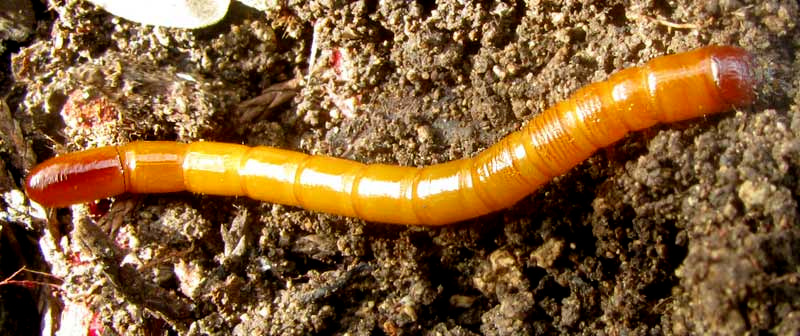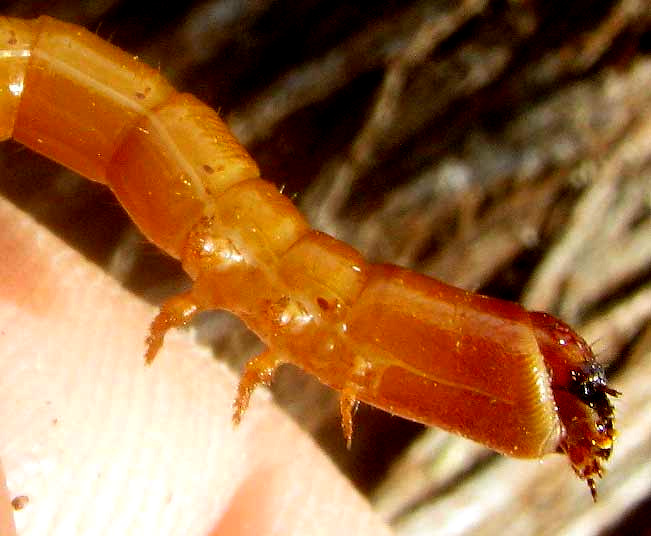Excerpts from Jim Conrad's
Naturalist Newsletter

from the November 10, 2013 Newsletter issued from the Frio Canyon Nature Education Center in the valley of the Dry Frio River in northern Uvalde County, southwestern Texas, on the southern border of the Edwards Plateau; elevation ~1750m (~5750 ft); N29.62°, W99.86°; USA
WIREWORM
I was grubbing up a long-dead Ashe Juniper stump from a prairie patch beside Juniper House when a slender, amber-colored critter I thought was an inch-long (25mm) millipede appeared on the ground next to the stump. Apparently he'd popped from the soil as I'd hacked at the stump's roots with a pickax. That's him above.
When I moved in for a close-up I saw that this wasn't a millipede at all -- didn't bear two pairs of legs on each body segment -- but rather was an insect larva with only six legs up front and no legs on any of the rear segments, as shown below:

Insect larvae like this are produced by beetles, and normally they're referred to as wireworms, though they're not worms at all. Calling something a wireworm isn't saying much because there are a lot of them. Wireworms are larvae of the Click Beetle Family, the Elateridae, widely distributed in North America in about 60 genera and 800 species. Moreover, there's a large group of "false wireworms," so similar it's hard to tell them apart, of the Darkling Beetle Family, the Tenebrionidae, of which more than 20,000 species are known.
When volunteer identifier Bea in Ontario saw the problem she figured she needed expert help, so our pictures were posted at BugGuide.Net. You can see what that looks like, and read viewers' comments, at https://bugguide.net/node/view/858844.
Unusual for the BugGuide crowd, days passed without anyone commenting. That was the first hint that we might have something unusual. I'd tried to figure out which wireworm it was, too, so already I knew that it didn't quite fit the way most wireworms and false wireworms look. The field mark that caught my attention can be seen in the close-up picture of the head area. The distance between the head and the first pair of legs is much longer than in any picture I've seen of a wireworm.
Finally one day Blaine in Atlanta, a microbiologist who identifies insects that might impact public health, for the CDC, posted his idea that our larva might be a member of the genus SELONODON, of which 25 species are listed for the US southern states. Selonodon belongs to the Robust Click Beetle Subfamily, the Cebrioninae.
On the BugGuide.Net page for Selonodon the beetle expert E.G. Riley is quoted as writing "To work out the taxonomy of this genus in Texas would be a lofty goal, and would require a lot of serious targeted field work year after year. A thorough working knowledge of the geology of Texas surface soils would probably be essential."
Therefore, here we're parking our information on the Internet under the name Selonodon, trusting that someday an earnest student of beetles will be very happy to see what we've found in thin soil of a hill made of early Cretaceous Glen Rose limestone and populated with Ashe Juniper and Texas Liveoak, and lots of prairie grasses.